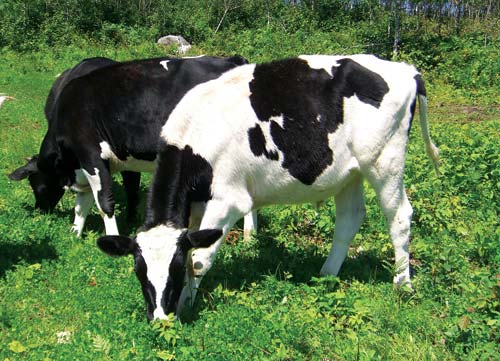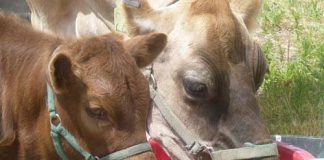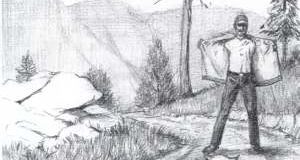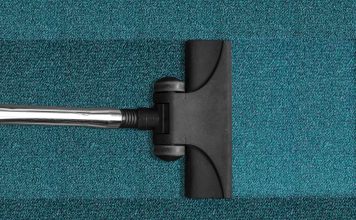 |
|
| Issue #137 • September/October, 2012 |
Meat is often the most expensive portion of our grocery bill, and it is getting more and more expensive every day. I’ve seen steaks “on sale” for more than $10 a pound. When you live on a low budget, like we do, buying $10 a pound steaks doesn’t happen. But two years ago, for a special occasion, I did buy two steaks at $7.99 a pound. I know my meat and chose two small T-bones that looked pretty good. I cooked them for dinner that evening and they smelled great frying with onions, but when they were on our plates and I began cutting into mine, I found those pretty steaks to be tougher than nails. I got so tired from chewing on mine that I gave the rest of it to my husband, who refused to waste those $7.99 a pound steaks. Talk about a disappointment. It was then and there that we vowed to raise our own meat.
Now we have at least one big steer to butcher every fall, along with our chickens, turkeys, goats, and starting this year, pigs. I also hunt venison every fall, so there’s hardly ever store-bought meat at our house anymore.
Let me tell you just how good our meat is. The taste is heavenly; there’s actual meat flavor in each and every bite. (How they can take away the flavor in store-bought meat is beyond me.) Talk about gourmet quality! And we know the animals are raised with love on good feed, with freedom and plenty of sunshine and without hormones, antibiotics, or cruelty. We also manage to do it inexpensively. For instance, we raise two big steers at the same time and sell the meat from one of them. This pays for nearly all the feed for both of them, as well as the butchering fee. As close as we can figure, we’re getting our gourmet beef for about 90 cents a pound.

These are some of our yearling steer calves on summer pasture; by winter they will weigh more than 1,000 pounds. Home-raised steers make good use of fenced pasture, changing grass and brush into tasty, tender beef.
Getting store-bought meat cheaper
To have inexpensive store-bought meat year around, it sure pays to can. I still buy some occasional “on sale” poultry and meats to can up, but only when it is very cheap. The three top choices here are seasonal hams, turkeys, and chicken breasts. I never, ever, buy these meats at their regular price. About two weeks before a holiday such as Easter, Thanksgiving, or Christmas, hams and turkeys usually go on sale for a very good price often a near give-away, which stores call a “loss leader.” They sell these meats at a loss to lead you into their store to fill your shopping carts with other groceries.
If you can restrain yourself, however, you can usually end up with several hams to can at home for a ridiculously low price.
Likewise, several times during the year, boneless, skinless, chicken breasts go on sale very cheaply. I have often bought many pounds, then brought them home to can up to use later during the year.
I can slices, chunks, and dices of each meat, finding I use more chunks and dices. For economy and health benefits, I’m cooking with less meat these days, using it more to flavor recipes than to serve a single large serving of meat alone. I can a whole lot of diced meats in half-pint jars and find that this works fine for Will and me since we are most often alone at the supper table. By using this canned meat, I can stretch each piece of meat (whole turkey, chicken breast, or half ham) out into several meals. This significantly reduces the cost of the meat in each meal. In fact, the last half ham I canned ended up giving me the meat ingredients for 14 meals. Then I boiled the bone with some meat still on it and canned up seven quarts of bean soup, too. That’s not bad for one half-ham at 99 cents per pound.
I can some quarts of large pieces of turkey breast and chicken breasts for special meals, where I also serve dressing, mashed potatoes, vegetables, and the works. It makes for a fast delicious meal in just a few minutes perfect when you have unexpected company.
Check with your grocery meat department manager. Often you can buy nearly out-of-date meats for a deep discount. Just can up what you can’t use right away. I used to buy 10 pounds of hamburger at a time this way, then can it up, either just lightly browned crumbles or as Sloppy Joes, taco filling, or spaghetti sauce with meat. Likewise, I used to buy roasts, then can up slices and chunks. You’ll not only save tons of cash but grow a nice fat pantry, too. And talk about convenience want a roast beef dinner, but don’t have the time? Just pull a quart of roast beef chunks out of your pantry, heat it up while you boil some potatoes and vegetables, and you’ll have a roast beef dinner in minutes.
Buying your meat locally
But you might not want to buy store meat after hearing how the animals have been raised. I don’t blame you, and that’s one reason we’re raising our own. I realize that not everyone has the room or time to do this. The good news is there is an alternative that is still cheaper than buying from a store.
Many small farmers out there raise meat animals to butchering size and sell this homegrown meat to buyers like you. The meat comes from animals that have happily grazed on pastures and have been fed no antibiotics or hormones. By cutting out the middleman, farmers are trying to earn more money to support their family farms. They’re just like us.
This farm-raised meat is sold by the whole, half, or quarter. The “whole” is buying the whole animal, either by “hanging weight” or by cut and wrapped weight. The hanging weight is the weight of the animal once it has been slaughtered and the head, feet, entrails, and skin have been removed. (All of these are heavy, so don’t make the mistake of buying a whole live animal by weight for a price only slightly lower than another sold by hanging weight.)
By buying a whole animal, you can figure on getting many pounds of ground meat, steaks, roasts, and ribs. Some processing plants smoke their meat as well, giving you bacon and hams, for a little extra cost. You give the processing plant your cutting order, which tells them how many pounds of ground meat you want in a package, how big the roasts should be cut, how many steaks or pork chops in a package, and how thick you would like them cut. When you get the animal back, all you see is white, butcher-wrapped packages of frozen meat. Your yield of actual meat from an animal ranges from about 60 to 70% depending on how much waste (bone and fat) there is. A live steer, weighing 1,400 pounds, may yield 1,000 pounds of hanging weight and only 650 pounds of wrapped meat, depending on how much waste there is.
In buying a “half,” you are buying half of the hanging carcass, sawn in half down the backbone. You get all the cuts you would in a whole carcass, just half as much.
Be aware that all such meat is sold by the “hanging weight,” which is the weight of the quarter, half, or whole, as it hangs before being cut into pieces. In all these cuts, there is some waste to be expected. Therefore, if you buy a front quarter that weighs 200 pounds, don’t expect 200 pounds of cut and wrapped meat it’s a little less, due to trimming and bone removal.
Typical cuts from a front quarter include ground meat, chuck and blade roasts (or steaks), boneless brisket, rib roasts (or steaks, such as rib eye), arm pot roasts (or steaks), and stewing meat.
The rear quarter is heavier and has more desirable cuts. A rear quarter typically contains ground meat, T-bone, porterhouse, New York strip and tenderloin steaks, sirloin steaks and/or roasts, round steaks and/or rump roasts, flank steaks, and stewing meat. If your family eats mostly hamburgers and roasts, then you can get by very nicely with a cheaper front quarter, but if you like plenty of steaks and larger roasts you’ll want a rear quarter, half, or whole beef.
All of this meat comes to you in boxes, sharp-frozen, wrapped in butcher paper, and labeled as to contents. And nearly all comes from meat processing plants that are licensed and inspected by the USDA.
The one problem with buying meat this way is that you must come up with a good chunk of change all at once. A lot of people save up, a little at a time, in order to buy farm-raised meat in the fall.

A small flock of chickens and turkeys can provide a family with lots of farm-fresh meat, even on a small or suburban homestead.
Cuts of meat and where it comes from
When you go to the store, you shop the meat counter and look at a wide array of cuts. There are rib steaks, boneless rib eye, sirloin roasts, sirloin steaks, tri-tip steaks, rump roast, round steak, arm steak, arm roast, top round roast, pork chops, whole pork loin, boneless pork loin, standing rib roast, and a whole lot more that individual stores make up for various cuts of meat. You might find 10 names for the same chunk of meat!
I thought I might take a little bit of the mystery out of meat cutting to help you out, especially if you’re buying a quarter or half an animal from a farmer. You’ll want to be able to tell the processing plant just what cuts you want. For instance, if you want a boneless pork loin, you can’t also get pork chops because pork chops contain a big round slice of the loin, plus a piece of rib and backbone. Conversely, if you want pork chops, you won’t get a boneless pork loin. Most steaks from a beef come either boneless or bone-in; this bone is a cut piece of rib plus a piece of the backbone.
The arm roasts are slices of the upper leg of a beef, containing a slice of meat around a slice of leg bone. Chuck roasts are often from the neck and front shoulder, containing both meat and bone. Rump roasts are (usually) boneless chunks of meat from the back quarter.
A fresh ham is usually a half of a pork ham, unsmoked. If it is smoked, it is a ham; both come from the hind quarter of a pig. A picnic ham is a smoked front shoulder. It has less meat and more bone than a ham does, but it tastes the same.
A sirloin roast comes from the front part of the loin. It can be cut boneless or with the ribs attached. But if you choose a sirloin roast, you won’t get sirloin steaks.
Bacon is the meat on the side of a pig which has been smoked. Side pork is the same meat, unsmoked. If you want both, you’ll need to buy a whole hog and have one slab smoked and the other left fresh.
Hamburger and ground pork are simply ground up scraps and lesser cuts. Some folks like lots of hamburger for its versatility in cooking so they choose fewer roasts and more hamburger. We like to have lots of ground pork for sausage making, so I choose to have some of the lesser roasts, like the front shoulder and neck ground.
You can also choose whether you want some of the lesser steaks cut as stewing meat. Stewing meat, like hamburger, is very versatile and makes a little meat go a long way in hearty recipes like stew and chili.
Cutting up game
If you like to hunt, you’ll find yourself cutting up a deer, moose, or elk carcass. You don’t have to be a meat cutter to “make meat!” I debone nearly all my venison, making roasts, steaks, and stewing meat. I just toss the scraps in a bowl and later grind them with some beef fat. I used to use pork fat, but soon found that the meat ground with beef fat didn’t get freezer burn and my family liked the taste better.
To cut up a game animal, I cut off the shoulders, which requires no sawing. Then I cut the neck off. Next, I cut off the rib cage, just in front of the hind quarters. Inside the rib cage, along the backbone, is a round strip of meat. This is the tenderloin and is the most tender, tasty piece of meat on the animal. Don’t miss it! Also, along the top of the rib cage, on either side of the backbone, you have the backstrap. This is the steak area where beef T-bone, sirloin, and rib steaks come from. As I debone all my venison, I simply run a knife along the ribs, then along the backbone, and fillet out this long, round, boneless piece of choice meat. From it I can slice steaks or chops to suit our family.
I cut pieces of rib off and package it to roast, if the animal is big enough. Then I take a meat saw and cut the hind quarters apart, down the backbone.
Now I have workable-sized pieces of meat. From these, I cut roasts, chops, steaks, and stewing meat. All of the scraps or tougher meats can be ground for hamburger.

We cross Nubian does with a Boer buck to get stocky kids that are good milkers. The buck kids provide plenty of juicy, tasty meat.
Raising meat chickens
Meat-producing chickens can be easily raised on a very small homestead. In fact, with the increased popularity of chickens, many municipalities now allow a few backyard chickens, provided the neighbors have no complaints. One helpful hint is to only have hens or pullets (young hens), not roosters. If you are raising chickens for meat alone, you can buy meat birds like Cornish rock broilers which are raised only to six weeks before butchering. Few roosters begin crowing by that age.
With meat chickens, try a small number to start with. Twelve is plenty. You can buy day-old chicks from a local feed store in the spring or split an order with a friend, as there is usually a minimum order of 25 birds. Housing for meat birds is basic. For twelve birds, you can get by with an 8×8-foot enclosure and have plenty of room. This can be a corner of your garage or other outbuilding. Cornish rock broilers are so heavy that they never roost, so you don’t even need to build roosts. And because you’re raising meat, you don’t need nest boxes either. All you need is a heat lamp hanging from the ceiling, a large cardboard box below the lamp to contain the baby chicks during the first two weeks of their life, a cheap plastic screw-on water jar, and a cheap plastic or metal tray chick feeder. Once the chicks have outgrown their box, baby feed, and waterers, you can just use a shallow pan for both.
Meat birds gain weight very quickly and should weigh about 6-8 pounds each by six weeks of age. If you enjoy raising these chickens, and most people do, you can raise several batches a year to fill your freezer and home can to fill your pantry too.
Raising meat rabbits
Even quieter than a pen of meat chickens are a couple hutches of meat rabbits. Rabbits, for the most part, are completely silent, disturbing not even the most finicky neighbors, and neither a pen of meat chickens nor a few hutches of rabbits have any odor to speak of if properly cared for. Rabbit meat is tender and very flavorful, tasting much like chicken (not kidding).
Rabbits are a little more difficult to raise successfully, so read some rabbit breeding books and visit some breeders before you begin.
Unlike with chickens, you won’t start with day-old rabbits and raise them up to butchering size. Instead you’ll start with an adult doe, breed her, then raise the bunnies up to butchering size. You’ll need at least two hutches and a growing pen. One hutch is for a doe and the other for a buck. You can’t keep a buck in with a doe, because does are very territorial and will fight a buck so viciously that some bucks have been castrated or severely injured in the process. (This is also why you never put a buck into the doe’s hutch to breed!)
Hutches do not have to be large; 2×3 feet is usually large enough to house a single rabbit. And hutches can be stacked, one above the other, with slanted trays underneath to let manure and urine fall off toward the back of the tier and not onto the rabbit below.
So a space 6×3 feet could hold three hutches, in a tier, with space behind to clean up the manure. Growing, weaned rabbits should have their own pen up until butchering time.
When deciding to raise rabbits, be sure you choose a good meat breed rabbit instead of just accepting someone’s “free” rabbit. A meat breed has been developed to grow quickly into usable, abundant meat. A “plain-old” rabbit will never get as large and will not provide as much meat per amount of feed consumed as will a meat breed. If you buy your initial trio (a buck and two does) from a reputable breeder (and rabbit breeders are usually very friendly, helpful people) they can answer your questions along the way and help you be successful.
A good doe should produce at least four litters each year. Six bunnies make up an average litter. That means for each doe you’ll end up with about 24 six-pound fryers (depending on the breed) each year. That equals 144 pounds of meat, all grown in a garage or small outbuilding.

Pigs are easy to raise and grow fast. Homegrown pork is so delicious you won’t believe it!
Goats and sheep for meat
If you raise dairy goats for their milk or raise sheep for their fiber, you already know you’ll have more buck kids and ram lambs than you need. Why not raise them up to use as family meat? They are very easy to raise and you probably already know the basics from caring for their parents. While you can butcher a kid or ram lamb at any time, you’ll get more meat per carcass if you wait until they are at least six months old. I prefer to raise them until they are a nearly a year old. I hate killing anything, so when I do, I want as much meat as possible from that animal.
Goat meat, called chevon, tastes like a cross between lamb and beef. It is fine grained and tender, and it does not taste “goaty!”
A yearling dairy goat kid should weigh 75 pounds, but a meat breed wether, such as a Boer, can weigh as much as 150 pounds at the same age; a ram lamb will be 45-65 pounds, depending on breed. It pays to consider the breeding of those kids you plan on raising to butcher. This is why we’ve crossed our Nubian (dairy) does with well-bred Boer bucks, then crossed those doelings back to Nubian, etc. We are getting very stocky goats that retain their milking ability. By raising stocky goats, we can use excess kids for meat animals.
Castrated ram lambs and bucklings will put on more gain in the meat department than do their intact brothers. This is easily done using a elastrator (banding) or emasculatome (pinching).
By raising several wether lambs or bucklings every year, you can harvest several hundred pounds of delectable meat. Less than an acre of good legume pasture will feed a dozen weanling to yearling lambs or wether goats, supplemented with a little good quality grain.
Raising a meat pig
There is no other animal like a pig for gaining weight quickly. It can start out a 20-pound baby in May and weigh 250 pounds or more in early winter. A pig’s requirements are few: a cozy house that’s just a little larger than a good-sized doghouse, a clean outdoor pen, fresh water, and plenty of good food. Luckily, much of this food can be waste from the homestead, as it is for our pigs. If you buy a small one in the early spring, it eats only a little store-bought feed. But it will quickly grow, making good use of extra garden produce like too-mature squash, weeds, clover, canning waste (tomato skins and seeds, carrot and potato peelings, pea pods, etc.), extra milk, and whey. Even extra eggs can turn to pork quite quickly! If you’re creative, you can feed a pig quite inexpensively. We feed ours day-old bread salvaged from stores, along with kitchen scraps and a little purchased chop from the feed mill.
You can quickly build a very good pig yard with free, salvaged pallets from lumberyards and other businesses around town. Most places are more than happy to give them to you so they don’t have to pay to dump them at the landfill.
While buying one pig to raise for pork in the fall makes good sense, so does buying a sow pig and raising a litter or two a year. In this way, you have your butcher pigs, but can sell all the extra pigs in the litter to help offset the cost of feeding your butcher pig and sow. With only one sow, you do need to make arrangements with a neighbor for having her bred. It really doesn’t pay to keep a boar to breed just one sow. He just eats too much! Don’t go “whole hog,” though, and get several sows. With the price of corn and other grain today, you can soon become “pig poor.” While there are many breeds of pigs, ranging from heritage breeds such as the Red Wattle and Large Black, any good, long breed or cross-breed pig will do the job on the homestead. Soon you’ll have plenty of delicious pork available at a very low cost a taste few people get to savor today.
Raising a calf for beef
Many people are doing what we do buying baby bottle calves to raise for beef. Most of our calves are Holstein bull calves. It is very hard to find a beef breed baby calf to buy, as farmers would be crazy to sell a three-day-old baby calf when they could quadruple or better their price in the fall after letting the calf suck on the mother all summer and fall. Some dairies cross their heifers with a beef bull, usually an Angus, for ease of calving, as Angus calves are notably smaller at birth than are many dairy breed calves. Jersey bull calves can usually be bought very cheaply and they do make very tasty meat, but it does take them longer to grow to butchering size than a larger breed like a Holstein.
The meat from all breeds tastes great much better than the so-called “Black Angus” meat at your grocery store. Beef breeds do have a bit more size to their steaks, but the taste is the same, regardless of breed.
We buy at least two calves in the early spring and raise them on the bottle for eight weeks while giving them a good quality powdered milk replacer. Then we put them in a large pen together and give them grain twice a day along with all the good quality hay they can eat. We have had much better luck buying calves from a dairy farmer than from an auction barn. Calves from a sale barn are stressed (who knows how long they’ve been hauled in a trailer?), then mixed together to trade germs. They quite frequently come down with scours (severe diarrhea) soon after coming home. As a veterinary technician, I’ve had plenty of experience treating calves with oral electrolytes and antibiotics, but even then, we’ve nearly lost a couple. I’ve had good luck with Sustain calf boluses (pills). These are a brand of sustained release sulfamethazine that works well on calf scours.
We raise at least one calf a year to butcher, butchering them when they are about 18 to 20 months old. We raise “extras” to sell privately, at the auction barn, or as meat. We’ve found that if we sell the meat by the half or quarter, we make a much better profit. The money we get from selling the beef reimburses us for the cost of feed along the way, and we get a nearly free beef from it.
We do have good pasture, however. If you don’t have much free land, this won’t work for you. Buying hay year around for several large cattle is expensive. The first winter, those spring calves are still quite small and don’t eat much hay. The next spring, they go on pasture and by winter, they are butchering size of about 1,000 to 1,200 pounds. If you have limited land, raising a single calf would probably be more economical although having two provides a buddy for the single calf. That way they are much less apt to try to get out of the fence and go searching for a “herd.”
As you progress in your search for self-reliant living, you may choose to try a new animal to raise, a different way to provide your own healthy, inexpensive, gourmet quality meat for your family. I started out with chickens a long time ago. Now we have not only chickens, but also turkeys, pigs, goats, and cattle. We add a deer or two to our pantry every year, too. We now have a very wide range of possibilities when someone asks, “What’s for dinner tonight?”













